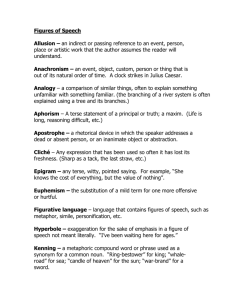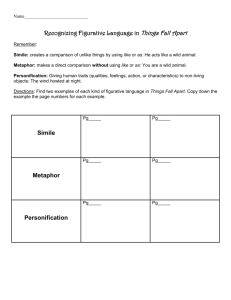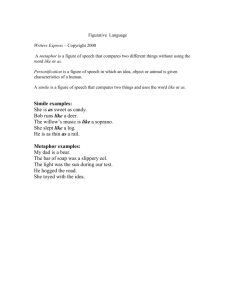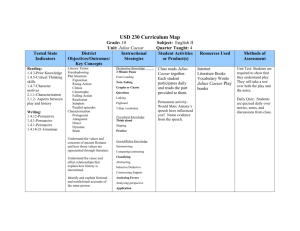figures of speech - Bobcat English II Pre-AP
advertisement
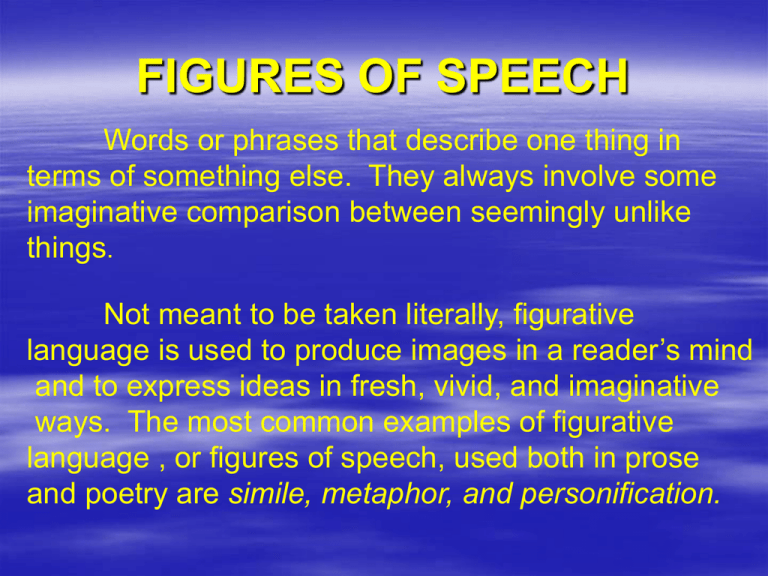
FIGURES OF SPEECH Words or phrases that describe one thing in terms of something else. They always involve some imaginative comparison between seemingly unlike things. Not meant to be taken literally, figurative language is used to produce images in a reader’s mind and to express ideas in fresh, vivid, and imaginative ways. The most common examples of figurative language , or figures of speech, used both in prose and poetry are simile, metaphor, and personification. Apostrophe A form of personification in which the absent or dead are spoken to as if present and the inanimate, as if animate. Antony. O judgment, thou art fled to brutish beasts, And men have lost their reason! (III, ii, 106-107) Julius Caesar Shakespeare addresses inanimate objects as though they have human understanding and empathy. Metaphor A comparison of two unlike things not using like or as. “You seek for knowledge and wisdom, as I once did; and I ardently hope that the gratification of your wishes may not be a serpent to sting you, as mine has been. “ Frankenstein The quote enhances understanding of the character’s emotions. Metonymy A form of metaphor, the name of one thing is applied to another thing with which it is closely associated. “When they called you crybaby Or poor or fatty or crazy And made you drink their acid And concealed it.” “Courage” In these lines the taunts of others hurt a person’s feelings. The speaker calls the taunts acid, an appropriate term because they do sting or burn a person emotionally. Oxymoron A form of paradox that combines a pair of opposite terms into a single unusual expression – “sweet sorrow” – “cold fire” Paradox Elements of a statement contradict each other. Although the statement may appear illogical, impossible, or absurd, it turns out to have a coherent meaning that reveals a hidden truth. “This shaking keeps me steady. I should know” “The Waking” His “shaking” is a sign he still lives and keeps him savoring his life while he still has it. Personification A metaphor that gives inanimate objects or abstract ideas human characteristics. – “But when he entered, misery and despair alone welcomed him.” The comparison of his companions to misery and despair suggest the depth of his unhappiness. – “The very winds whispered in soothing accents, and maternal nature bade me weep no more.” Frankenstein The character compares nature to a mother soothing her son. Pun A play on words that are identical or similar in sound but have sharply diverse meanings. Puns can have serious as well as humorous uses. “Ask for me tomorrow, and you shall find me a grave man.” Romeo and Juliet Grave means serious and also means he will be in the grave “I know not, gentlemen, what you intend, Who else must be let blood, who else is rank. Julius Caesar Rank means what level in the hierarchy and something that smells bad. Simile A comparison of two different things or ideas through the use of like or as. – “The saintly soul of Elizabeth shone like a shrine-dedicated lamp in our peaceful home. Elizabeth’s “saintly soul” is compared to a “shrine-dedicated lamp” indicating the purity and loyalty of her soul. Synecdoche • A form of metaphor where part of something is used to signify the whole. • “All hands on deck.” • “Friends, Romans, Countrymen, lend me your ears” (III, ii, 75). Julius Caesar
